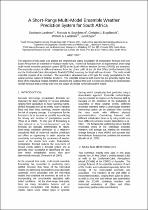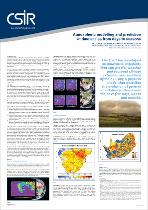JavaScript is disabled for your browser. Some features of this site may not work without it.
- ResearchSpace
- →
- Research Publications/Outputs
- →
- Conference Publications
- →
- View Item
| dc.contributor.author |
Landman, WA

|
|
| dc.contributor.author |
Engelbrecht, F

|
|
| dc.contributor.author |
Park, R

|
|
| dc.contributor.author |
Bopape, Mary-Jane M

|
|
| dc.contributor.author |
Lötter, D

|
|
| dc.date.accessioned | 2010-09-02T08:14:38Z | |
| dc.date.available | 2010-09-02T08:14:38Z | |
| dc.date.issued | 2010-09-01 | |
| dc.identifier.citation | Landman, W.A., Engelbrecht, F., Park, R. et al. 2010. Atmospheric modelling and prediction at time scales from days to seasons. CSIR 3rd Biennial Conference 2010. Science Real and Relevant. CSIR International Convention Centre, Pretoria, South Africa, 30 August – 01 September 2010, pp 8 | en |
| dc.identifier.uri | http://hdl.handle.net/10204/4285 | |
| dc.description | CSIR 3rd Biennial Conference 2010. Science Real and Relevant. CSIR International Convention Centre, Pretoria, South Africa, 30 August – 01 September 2010 | en |
| dc.description.abstract | Daily weather forecasts are skilful and are initial-value problems, while at the seasonal time scale, slowly varying surface forcing, for example from the tropical Pacific Ocean, can induce atmospheric anomalies that are sufficiently long-lasting and predictable. While the chaotic nature of the atmosphere imposes a finite limit to the predictability of weather to less than two weeks, El Niño and La Niña oscillations and their impact on atmospheric anomalies could be predictable several months in advance. There is a growing trend internationally towards the development of operational prediction systems that will bridge the gap between initial-value problem-based weather forecasts and boundary-value problem-based seasonal forecasts. One of the ways to bridge this gap is through the use of common forecast systems to predict for multiple time scales. The time scales considered here are from short-range forecasts of a few days ahead through to the longer-range forecasting of seasonal anomalies several months ahead. The geographical area considered is southern Africa. Skillfully predicting rainfall and temperatures and their extremes over various time scales have societal and economic benefits for the region, and knowing well ahead of time whether or not a coming summer season may be subjected to El Niño-related droughts can assist in risk aversion planning. The Atmospheric Modelling Strategic Initiative (AMSI) of CSIR Natural Resources and the Environment was established in 2009. This initiative is tasked with the development of dynamic simulation and forecast systems that are based on the principles that govern the evolution of the atmosphere and the ocean, and the interactions between the two. These systems are required to provide skillful operational weather to seasonal forecasts, and produce multi-decadal climate change projections. This paper focuses on the shorter time-range from days to seasons. The conformal-cubic atmospheric model (CCAM) is an atmospheric global circulation model (AGCM) that can operate at quasi-uniform horizontal resolution or alternatively in stretched-grid variable-resolution mode, to provide high-resolution forecasts over an area of interest. The CCAM code has been formulated with computational efficiency in mind, and may be integrated using parallel processing capabilities on computer clusters. This model is currently running on the multi-processor machines of AMSI, and provides high-resolution (~15 km) weather forecasts 7 days ahead, and coarse-resolution (~200 km) longer-range forecasts up to 5 months ahead. The weather forecasts provide an estimate of impending weather extremes such as cold snaps and flash floods associated with deep convection. The CCAM’s seasonal forecasts are also combined with seasonal forecasts produced locally and abroad, but model combination lies outside the scope of this paper, which focuses on the CCAM model only. Forecasts should be produced probabilistically in order to provide users with the required forecast uncertainties. The paper introduces the CCAM as a forecasting system administered by AMSI and discusses forecast skill estimates. | en |
| dc.language.iso | en | en |
| dc.publisher | CSIR | en |
| dc.subject | Atmospheric modelling | en |
| dc.subject | Time scales | en |
| dc.subject | Weather forecasts | en |
| dc.subject | El Niño oscillations | en |
| dc.subject | La Niña oscillations | en |
| dc.subject | CSIR Conference 2010 | en |
| dc.title | Atmospheric modelling and prediction at time scales from days to seasons | en |
| dc.type | Conference Presentation | en |
| dc.identifier.apacitation | Landman, W., Engelbrecht, F., Park, R., Bopape, M. M., & Lötter, D. (2010). Atmospheric modelling and prediction at time scales from days to seasons. CSIR. http://hdl.handle.net/10204/4285 | en_ZA |
| dc.identifier.chicagocitation | Landman, WA, F Engelbrecht, R Park, Mary-Jane M Bopape, and D Lötter. "Atmospheric modelling and prediction at time scales from days to seasons." (2010): http://hdl.handle.net/10204/4285 | en_ZA |
| dc.identifier.vancouvercitation | Landman W, Engelbrecht F, Park R, Bopape MM, Lötter D, Atmospheric modelling and prediction at time scales from days to seasons; CSIR; 2010. http://hdl.handle.net/10204/4285 . | en_ZA |
| dc.identifier.ris | TY - Conference Presentation AU - Landman, WA AU - Engelbrecht, F AU - Park, R AU - Bopape, Mary-Jane M AU - Lötter, D AB - Daily weather forecasts are skilful and are initial-value problems, while at the seasonal time scale, slowly varying surface forcing, for example from the tropical Pacific Ocean, can induce atmospheric anomalies that are sufficiently long-lasting and predictable. While the chaotic nature of the atmosphere imposes a finite limit to the predictability of weather to less than two weeks, El Niño and La Niña oscillations and their impact on atmospheric anomalies could be predictable several months in advance. There is a growing trend internationally towards the development of operational prediction systems that will bridge the gap between initial-value problem-based weather forecasts and boundary-value problem-based seasonal forecasts. One of the ways to bridge this gap is through the use of common forecast systems to predict for multiple time scales. The time scales considered here are from short-range forecasts of a few days ahead through to the longer-range forecasting of seasonal anomalies several months ahead. The geographical area considered is southern Africa. Skillfully predicting rainfall and temperatures and their extremes over various time scales have societal and economic benefits for the region, and knowing well ahead of time whether or not a coming summer season may be subjected to El Niño-related droughts can assist in risk aversion planning. The Atmospheric Modelling Strategic Initiative (AMSI) of CSIR Natural Resources and the Environment was established in 2009. This initiative is tasked with the development of dynamic simulation and forecast systems that are based on the principles that govern the evolution of the atmosphere and the ocean, and the interactions between the two. These systems are required to provide skillful operational weather to seasonal forecasts, and produce multi-decadal climate change projections. This paper focuses on the shorter time-range from days to seasons. The conformal-cubic atmospheric model (CCAM) is an atmospheric global circulation model (AGCM) that can operate at quasi-uniform horizontal resolution or alternatively in stretched-grid variable-resolution mode, to provide high-resolution forecasts over an area of interest. The CCAM code has been formulated with computational efficiency in mind, and may be integrated using parallel processing capabilities on computer clusters. This model is currently running on the multi-processor machines of AMSI, and provides high-resolution (~15 km) weather forecasts 7 days ahead, and coarse-resolution (~200 km) longer-range forecasts up to 5 months ahead. The weather forecasts provide an estimate of impending weather extremes such as cold snaps and flash floods associated with deep convection. The CCAM’s seasonal forecasts are also combined with seasonal forecasts produced locally and abroad, but model combination lies outside the scope of this paper, which focuses on the CCAM model only. Forecasts should be produced probabilistically in order to provide users with the required forecast uncertainties. The paper introduces the CCAM as a forecasting system administered by AMSI and discusses forecast skill estimates. DA - 2010-09-01 DB - ResearchSpace DP - CSIR KW - Atmospheric modelling KW - Time scales KW - Weather forecasts KW - El Niño oscillations KW - La Niña oscillations KW - CSIR Conference 2010 LK - https://researchspace.csir.co.za PY - 2010 T1 - Atmospheric modelling and prediction at time scales from days to seasons TI - Atmospheric modelling and prediction at time scales from days to seasons UR - http://hdl.handle.net/10204/4285 ER - | en_ZA |







